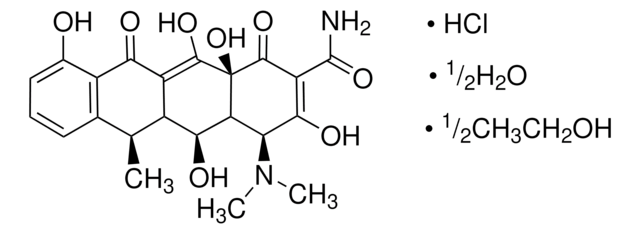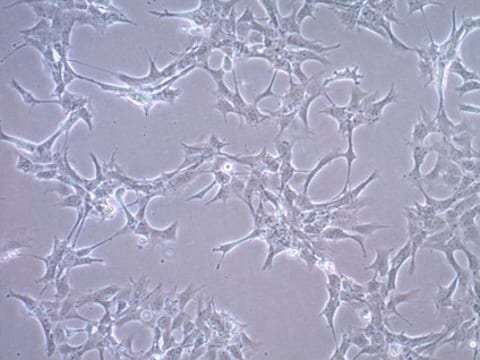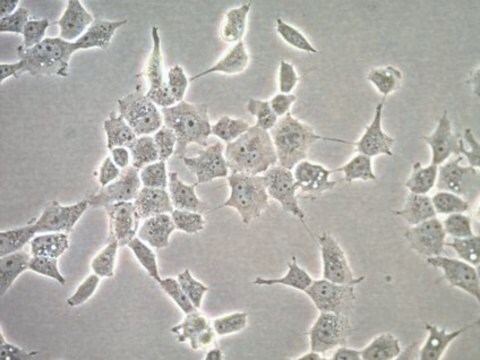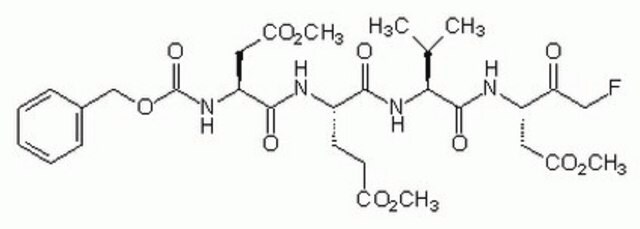SCC129
HT-22 Mouse Hippocampal Neuronal Cell Line
HT-22 mouse neuronal cell line is a valuable cell model for studies of glutamate-induced toxicity in neuronal cells.
Sinonimo/i:
HT22 Cell Line
Autenticatiper visualizzare i prezzi riservati alla tua organizzazione & contrattuali
About This Item
Codice UNSPSC:
41106514
eCl@ss:
32011203
Prodotti consigliati
Origine biologica
mouse
Livello qualitativo
tecniche
cell based assay: suitable
Condizioni di spedizione
dry ice
Categorie correlate
Descrizione generale
Glutamate is a major excitatory neurotransmitter used as a signaling molecule between nerve cells and is involved in most aspects of normal brain function including cognition, learning and memory. Various glutamate receptors are found throughout the brain and include NMDA, AMPA/kainate and metabotropic receptors (mGluR). Normal glutamate levels are essential for normal brain function, however high levels may result in over-excitation of nerve cells, leading to eventual cell damage and/or cell death. Glutamate-induced cytotoxicity has been implicated in neurodegenerative disorders such as Alzheimer’s disease, Huntington’s disease and Parkinson’s disease along with other conditions including spinal cord injury and multiple sclerosis. Therapies that may inhibit or reduce the effects of glutamate activity are thus of great therapeutic interest.
HT-22 is an immortalized mouse hippocampal cell line subcloned from the HT-4 cell line . The parental HT-4 cell line was derived from the immortalization of mouse neuronal tissues with a temperature sensitive SV40 T-antigen . HT-22 is highly sensitive to glutamate and is thus frequently used as a model system to study glutamate-induced toxicity in neuronal cells.
Descrizione della linea cellulare
Neural Lineage Cells
Applicazioni
EMD Millipore has a limited license to sell this product for research use only, and not for any commercial uses. Excluded commercial uses include without limitation manufacturing, providing a service, therapeutic, diagnostic and prophylactic uses, and any other commercial uses. Use of this product by a purchaser for any purpose other than for research is unauthorized and prohibited.
Inquiries about licensing for commercial or other uses should be directed to:
Office of Technology Development
The Salk Institute for Biological Studies
10010 North Torrey Pines Road
La Jolla, CA 92037
Phone: (858) 453-4100 extension 1278
Email: OTD@salk.edu
Inquiries about licensing for commercial or other uses should be directed to:
Office of Technology Development
The Salk Institute for Biological Studies
10010 North Torrey Pines Road
La Jolla, CA 92037
Phone: (858) 453-4100 extension 1278
Email: OTD@salk.edu
Research Category
Neuroscience
Toxicity
Neuroscience
Toxicity
Qualità
• Each vial contains ≥ 1X106 viable cells.
• Cells are tested negative for infectious diseases by a Mouse Essential CLEAR panel by Charles River Animal Diagnostic Services.
• Cells are verified to be of mouse origin and negative for inter-species contamination from rat, chinese hamster, Golden Syrian hamster, human and non-human primate (NHP) as assessed by a Contamination Clear panel by Charles River Animal Diagnostic Services.
• Cells are negative for mycoplasma contamination.
• Cells are tested negative for infectious diseases by a Mouse Essential CLEAR panel by Charles River Animal Diagnostic Services.
• Cells are verified to be of mouse origin and negative for inter-species contamination from rat, chinese hamster, Golden Syrian hamster, human and non-human primate (NHP) as assessed by a Contamination Clear panel by Charles River Animal Diagnostic Services.
• Cells are negative for mycoplasma contamination.
Stoccaggio e stabilità
Store in liquid nitrogen. The cells can be cultured for at least 10 passages after initial thawing without significantly affecting the cell marker expression and functionality.
Codice della classe di stoccaggio
12 - Non Combustible Liquids
Classe di pericolosità dell'acqua (WGK)
WGK 2
Punto d’infiammabilità (°F)
Not applicable
Punto d’infiammabilità (°C)
Not applicable
Certificati d'analisi (COA)
Cerca il Certificati d'analisi (COA) digitando il numero di lotto/batch corrispondente. I numeri di lotto o di batch sono stampati sull'etichetta dei prodotti dopo la parola ‘Lotto’ o ‘Batch’.
Possiedi già questo prodotto?
I documenti relativi ai prodotti acquistati recentemente sono disponibili nell’Archivio dei documenti.
Kyung-Ran Kim et al.
Experimental & molecular medicine, 53(7), 1134-1147 (2021-07-09)
Calbindin, a major Ca2+ buffer in dentate granule cells (GCs), plays a critical role in shaping Ca2+ signals, yet how it regulates neuronal function remains largely unknown. Here, we found that calbindin knockout (CBKO) mice exhibited dentate GC hyperexcitability and
J B Davis et al.
Brain research, 652(1), 169-173 (1994-07-25)
A neuronal cell line, HT-22, is sensitive to glutamate cytotoxicity via a non-receptor mediated oxidative pathway. 12-O-tetradecanoylphorbol-13-acetate (TPA), an activator of protein kinase C, blocks this glutamate-induced cell death. Down-regulation of protein kinase C eliminates the protection against glutamate cytotoxicity
Mitsuaki Nishikimi et al.
Annals of neurology, 91(3), 389-403 (2022-01-04)
Cardiac arrest (CA) is a major health burden with brain damage being a significant contributor to mortality. We found lysophosphatidylcholine (LPC), including a species containing docosahexaenoic acid (LPC-DHA), was significantly decreased in plasma post-CA, supplementation of which significantly improved neurological
Peng Huang et al.
Annals of translational medicine, 9(20), 1594-1594 (2021-11-19)
Phosphodiesterase 4D (PDE4D) inhibitor is commonly used to treat depression, but side effects seriously decrease its efficacy. PDE4D was a downstream target mRNA of miR-139-5p. Therefore, we examined the effects of hippocampal miR-139-5p gain- and loss-of-function on depression-like behaviors, the
Oliwia Koszła et al.
Molecules (Basel, Switzerland), 27(7) (2022-04-13)
Neurodegenerative and mental diseases are serious medical, economic and social problems. Neurodegeneration is referred to as a pathological condition associated with damage to nerve cells leading to their death. Treatment of neurodegenerative diseases is at present symptomatic only, and novel
Il team dei nostri ricercatori vanta grande esperienza in tutte le aree della ricerca quali Life Science, scienza dei materiali, sintesi chimica, cromatografia, discipline analitiche, ecc..
Contatta l'Assistenza Tecnica.






